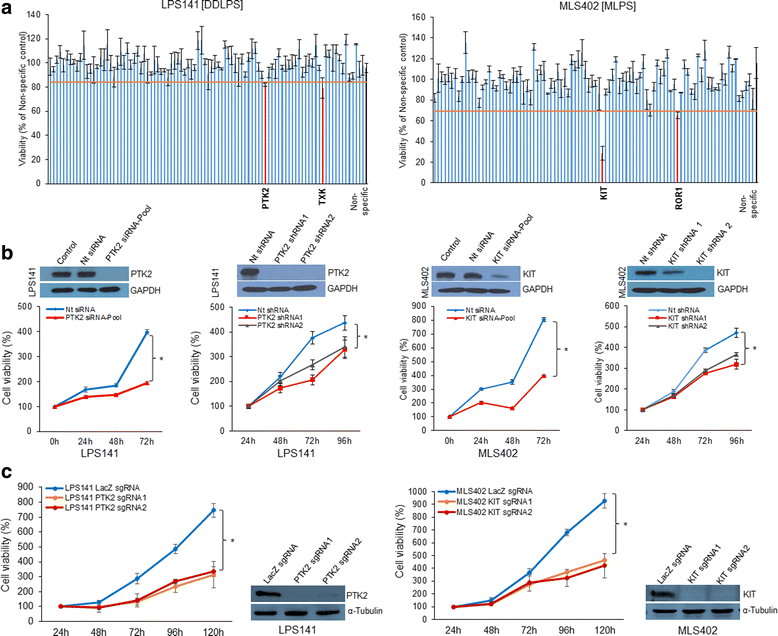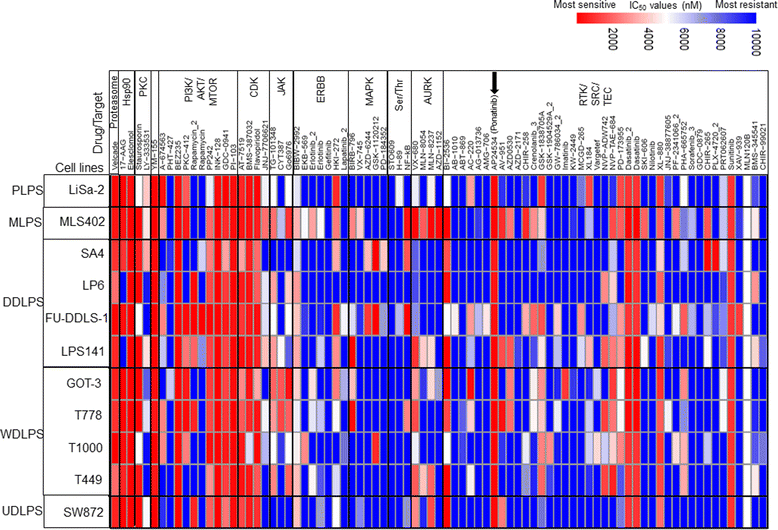Kinase profiling of liposarcomas using RNAi and drug screening assays identified druggable targets
- PMID: 29132397
- PMCID: PMC5683536
- DOI: 10.1186/s13045-017-0540-x
Kinase profiling of liposarcomas using RNAi and drug screening assays identified druggable targets
Abstract
Background: Liposarcoma, the most common soft tissue tumor, is understudied cancer, and limited progress has been made in the treatment of metastatic disease. The Achilles heel of cancer often is their kinases that are excellent therapeutic targets. However, very limited knowledge exists of therapeutic critical kinase targets in liposarcoma that could be potentially used in disease management.
Methods: Large RNAi and small-molecule tyrosine kinase inhibitor screens were performed against the proliferative capacity of liposarcoma cell lines of different subtypes. Each small molecule inhibitor was either FDA approved or in a clinical trial.
Results: Screening assays identified several previously unrecognized targets including PTK2 and KIT in liposarcoma. We also observed that ponatinib, multi-targeted tyrosine kinase inhibitor, was the most effective drug with anti-growth effects against all cell lines. In vitro assays showed that ponatinib inhibited the clonogenic proliferation of liposarcoma, and this anti-growth effect was associated with apoptosis and cell cycle arrest at the G0/G1 phase as well as a decrease in the KIT signaling pathway. In addition, ponatinib inhibited in vivo growth of liposarcoma in a xenograft model.
Conclusions: Two large-scale kinase screenings identified novel liposarcoma targets and a FDA-approved inhibitor, ponatinib with clear anti-liposarcoma activity highlighting its potential therapy for treatment of this deadly tumor.
Keywords: Kinase inhibitor; Liposarcoma; Ponatinib; Therapeutics.
Conflict of interest statement
Ethics approval
All animal experiments were performed according to the ethical regulations of Institutional Animal Care and Use Committee of the National University of Singapore.
Consent for publication
Not applicable
Competing interests
The authors have declared a conflict of interest. Research support for JWT receive from Aptose, Array, AstraZeneca, Constellation, Genentech, Gilead, Incyte, Janssen, Seattle Genetics, Syros, Takeda, and the Scientific Advisory Board for Leap Oncology.
Publisher’s Note
Springer Nature remains neutral with regard to jurisdictional claims in published maps and institutional affiliations.
Figures






Similar articles
-
Ponatinib Combined With Rapamycin Causes Regression of Murine Venous Malformation.Arterioscler Thromb Vasc Biol. 2019 Mar;39(3):496-512. doi: 10.1161/ATVBAHA.118.312315. Arterioscler Thromb Vasc Biol. 2019. PMID: 30626204 Free PMC article.
-
Novel multiple tyrosine kinase inhibitor ponatinib inhibits bFGF-activated signaling in neuroblastoma cells and suppresses neuroblastoma growth in vivo.Oncotarget. 2017 Jan 24;8(4):5874-5884. doi: 10.18632/oncotarget.11580. Oncotarget. 2017. PMID: 27564113 Free PMC article.
-
Ponatinib (AP24534) is a novel potent inhibitor of oncogenic RET mutants associated with thyroid cancer.J Clin Endocrinol Metab. 2013 May;98(5):E811-9. doi: 10.1210/jc.2012-2672. Epub 2013 Mar 22. J Clin Endocrinol Metab. 2013. PMID: 23526464
-
Ponatinib for the treatment of chronic myeloid leukemia and Philadelphia chromosome-positive acute lymphoblastic leukemia.Drugs Today (Barc). 2013 Apr;49(4):261-9. doi: 10.1358/dot.2013.49.4.1950147. Drugs Today (Barc). 2013. PMID: 23616953 Review.
-
Ponatinib: A new tyrosine kinase inhibitor for the treatment of chronic myeloid leukemia and Philadelphia chromosome-positive acute lymphoblastic leukemia.Ann Pharmacother. 2013 Nov;47(11):1540-6. doi: 10.1177/1060028013501144. Epub 2013 Nov 21. Ann Pharmacother. 2013. PMID: 24265264 Review.
Cited by
-
Novel Therapeutic Insights in Dedifferentiated Liposarcoma: A Role for FGFR and MDM2 Dual Targeting.Cancers (Basel). 2020 Oct 20;12(10):3058. doi: 10.3390/cancers12103058. Cancers (Basel). 2020. PMID: 33092134 Free PMC article.
-
Multifaceted role of mTOR (mammalian target of rapamycin) signaling pathway in human health and disease.Signal Transduct Target Ther. 2023 Oct 2;8(1):375. doi: 10.1038/s41392-023-01608-z. Signal Transduct Target Ther. 2023. PMID: 37779156 Free PMC article. Review.
-
Potential of guggulsterone, a farnesoid X receptor antagonist, in the prevention and treatment of cancer.Explor Target Antitumor Ther. 2020;1(5):313-342. doi: 10.37349/etat.2020.00019. Epub 2020 Oct 30. Explor Target Antitumor Ther. 2020. PMID: 36046484 Free PMC article. Review.
-
A comprehensive review of genetic alterations and molecular targeted therapies for the implementation of personalized medicine in acute myeloid leukemia.J Mol Med (Berl). 2020 Aug;98(8):1069-1091. doi: 10.1007/s00109-020-01944-5. Epub 2020 Jul 3. J Mol Med (Berl). 2020. PMID: 32620999 Review.
-
Recent Studies on Ponatinib in Cancers Other Than Chronic Myeloid Leukemia.Cancers (Basel). 2018 Nov 9;10(11):430. doi: 10.3390/cancers10110430. Cancers (Basel). 2018. PMID: 30423915 Free PMC article. Review.
References
-
- Demetri GD, von Mehren M, Jones RL, Hensley ML, Schuetze SM, Staddon A, Milhem M, Elias A, Ganjoo K, Tawbi H, et al. Efficacy and safety of trabectedin or dacarbazine for metastatic liposarcoma or leiomyosarcoma after failure of conventional chemotherapy: results of a phase III randomized multicenter clinical trial. J Clin Oncol. 2016;34:786–793. doi: 10.1200/JCO.2015.62.4734. - DOI - PMC - PubMed
MeSH terms
Substances
Grants and funding
LinkOut - more resources
Full Text Sources
Other Literature Sources
Research Materials
Miscellaneous

